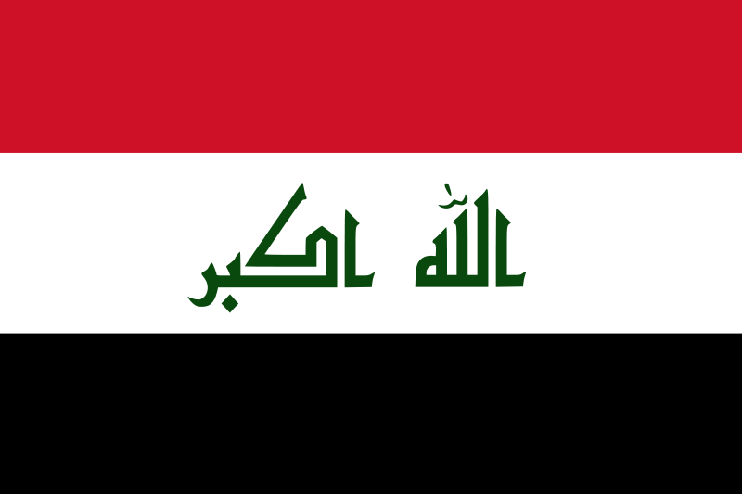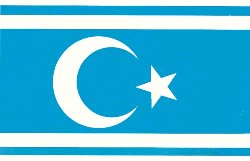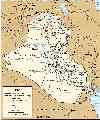 Kirkuk
is the largest Azeri city in Iraq. The Turkic population speaks the Southern
dialect of the Azeri language, and besides Kirkuk this Turkic population
is to be found in the Erbil, Mosul/Ninawa and Deyalah provinces. In tows
and villages southeast from Kirkuk, large numbers of Azeris live
as far as Al Miqdadiyah, Khanqin, and Mandali. Azeri speakers in Iraq are
usually mentioned as Turkman, Turkmen or Turkoman, they use
the Arabic script and many have Arabic or Kurdish as a second language.
Kirkuk
is the largest Azeri city in Iraq. The Turkic population speaks the Southern
dialect of the Azeri language, and besides Kirkuk this Turkic population
is to be found in the Erbil, Mosul/Ninawa and Deyalah provinces. In tows
and villages southeast from Kirkuk, large numbers of Azeris live
as far as Al Miqdadiyah, Khanqin, and Mandali. Azeri speakers in Iraq are
usually mentioned as Turkman, Turkmen or Turkoman, they use
the Arabic script and many have Arabic or Kurdish as a second language.
 The
first Turkman were brought to Iraq by the Ommiad ruler Ubeydullah bin Ziyad
in 54 Hegira. The invasion of Iraq by the Seljuk ruler Tugrul Bey in 1055
marked the beginning of Turkish control that lasted till 1918. The 11th
and 12th centuries saw the strongest flux of Turkman settlers to Mesopotamia.
Wars and the resulting treaties in the area eventually separated the Azeris
in Iraq and Azerbaijan. Their languages, sharing the same root - the Oghuz
group of Turkic languages - however, stayed basically the same. Furthermore,
several important Azeri revered intellectuals - classical poets and scientists
- are buried in Iraq. Several towns and villages found around Kirkuk bear
the sames names as towns in Azerbaijan, such as Aghdash, Aghdam, Bilava,
Aghsu, Guruchay, Boyat, Garabagh, Garagoyunlu, Amirli, Yayji, Yandija,
Mardinli, Uchtapa, Khasa , Khasadaghli Chardakhli.
The
first Turkman were brought to Iraq by the Ommiad ruler Ubeydullah bin Ziyad
in 54 Hegira. The invasion of Iraq by the Seljuk ruler Tugrul Bey in 1055
marked the beginning of Turkish control that lasted till 1918. The 11th
and 12th centuries saw the strongest flux of Turkman settlers to Mesopotamia.
Wars and the resulting treaties in the area eventually separated the Azeris
in Iraq and Azerbaijan. Their languages, sharing the same root - the Oghuz
group of Turkic languages - however, stayed basically the same. Furthermore,
several important Azeri revered intellectuals - classical poets and scientists
- are buried in Iraq. Several towns and villages found around Kirkuk bear
the sames names as towns in Azerbaijan, such as Aghdash, Aghdam, Bilava,
Aghsu, Guruchay, Boyat, Garabagh, Garagoyunlu, Amirli, Yayji, Yandija,
Mardinli, Uchtapa, Khasa , Khasadaghli Chardakhli.
Calling the Azeri speakers "Turkman" dates from the Seljuk period. Currently the Turkman are represented by the 'Turkman Front', established in 1995 joining several Turkman political and social organizations. The Turkman community's two main parties are divided in their support. One works in co-operation with the Kurdish authorities, the other is backed by Turkey and opposes a Kurdish state in northern Iraq - especially one that would adopt Kirkuk as its capital.
Turkey has tried to exert a strong influence on the Turkman, and often written Turkish is used by the Turkman, as opposed to the traditional Southern-Azeri dialect which predominates in the spoken form. In spite of this, from the Arab point of view, the language of the Iraqi Turkman is regularly mentioned simply as Turkish. The number of Turkman is estimated a 2.0-2.5 million - the third largest ethnic group in Iraq after the Arabs and Kurds. Historically, the Turkman formed a cultural buffer zone between the Arabs in the South and the Kurds in the north.
Under the Iraqi constitution of 1925 both
Turkman and Kurds had the right to use their own languages in schools,
government offices and press. By 1972 the Iraqi government prohibited the
both the study of the Turkman language and the Turkman media and in 1973
any reference to the Turkman was omitted from the provisional constitution.
During the 1980's the regime of the Baath party prohibited even the public
use of the Turkman language and the constitution of 1990 only states the
the "people of Iraq consists of Arabs and Kurds".
In 2003 the collapse of Saddam Hussein's
Baathist government brought new possibilities to the Turkman community
that will have to be materialized in a difficult context, balancing the
interests of Turkey and of the global super-power.
 Kirkuk
is located in northern Iraq, about 250 km north of the capital Baghdad
near the foot of the Zagors Montains. Railway lines provide good connections
with Baghdad and Arbil. Kirkuk has a population of over 600.000 and is
the capital of the Al-Tamin governorate (muhafazah). Until 1974 the city
was the capital of the Kirkuk governorate, which was reduced to a quarter
of its original size by the Baghdad government, as a way of controlling
the influence of the Azeri speaking population. The Iraqi government has
also been very active in settling Arabs in the area as a way of inverting
the ethnic balance. Turkman leaders say thousands of their community were
forced into destitution in northern Iraq, while up to 20,000 made their
way illegally to Europe throughout the 1990s. Currently Kirkuk still has
a Turkman majority but the Kurdish and Arab communities are also important.
Kirkuk
is located in northern Iraq, about 250 km north of the capital Baghdad
near the foot of the Zagors Montains. Railway lines provide good connections
with Baghdad and Arbil. Kirkuk has a population of over 600.000 and is
the capital of the Al-Tamin governorate (muhafazah). Until 1974 the city
was the capital of the Kirkuk governorate, which was reduced to a quarter
of its original size by the Baghdad government, as a way of controlling
the influence of the Azeri speaking population. The Iraqi government has
also been very active in settling Arabs in the area as a way of inverting
the ethnic balance. Turkman leaders say thousands of their community were
forced into destitution in northern Iraq, while up to 20,000 made their
way illegally to Europe throughout the 1990s. Currently Kirkuk still has
a Turkman majority but the Kurdish and Arab communities are also important.
 In
post-Saddam Iraq, Kirkuk reveals some symptoms of becoming the centre of
a struggle between the Turkmen and the Kurds, both of whom aspire to domination
in the area.
In
post-Saddam Iraq, Kirkuk reveals some symptoms of becoming the centre of
a struggle between the Turkmen and the Kurds, both of whom aspire to domination
in the area.
The first commercial oil field in Iraq
was developed in Kirkuk in 1927. Today Kirkuk is at the centre of one of
the richest oil producing areas in the middle east, and pipelines connect
it to the Mediterranean ports of Tripoli in Lebanon and Yumurtalik in Turkey.
However the oil industry was affected first by the war with Iran and later
by the American aggression and blockade. The area has also an textile industries
and a strong agricultural sector, producing wheat, barley, fruits and sheep.
 The
city is built by the Hasa river on an area with archaeologic remains over
5000 years old, the city reached great prominence in the 10th and 11th
centuries, under Assyrian rule when it was known as Arrapha. The oldest
part of the town is clustered around a citadel built on an ancient tell,
or mound. Saddam Hussein's government had some unpleasant interventions
in Kirkuk's architecture, including the demolition of the Muhammediye Mosque,
but the city is well worth visiting for the many ancient buildings and
specially for the castle and citadel, and the 6th century Nabi Danial mosque
located in the old quarter. Don't miss the ethernal fire at Babagurgur.
The
city is built by the Hasa river on an area with archaeologic remains over
5000 years old, the city reached great prominence in the 10th and 11th
centuries, under Assyrian rule when it was known as Arrapha. The oldest
part of the town is clustered around a citadel built on an ancient tell,
or mound. Saddam Hussein's government had some unpleasant interventions
in Kirkuk's architecture, including the demolition of the Muhammediye Mosque,
but the city is well worth visiting for the many ancient buildings and
specially for the castle and citadel, and the 6th century Nabi Danial mosque
located in the old quarter. Don't miss the ethernal fire at Babagurgur.
Outside Kirkuk
Qalat Jarmo:
Located east of Kirkuk, Qalat Jarmo is
an important prehistoric archeological site. The site became knwon for
revealing traces of one of the world's first village farming communities.
The approximately dozen layers of architectural building and renovation
yeild evidence of domesticated wheats and barley and of domesticated dogs
and goats, suggesting the achievement of a settled agricultural way of
life. Other artifacts found at Qalat Jarmo, such as flint sickle
blades, milling stones, and - in the uppermost layers only - pottery, hint
at the technological innovations made in response to the new way of food
production. The original occupation of the site is estimated to have occurred
at about 7000 BC.
Nuzu:
Modern Yorghan Tepe, Nuzu is an ancient
Mesopotamian city, located southwest of Kirkuk. Excavations revealed revealed
material extending from the prehistoric period to Roman, Parthian, and
Sasanian periods. In Akkadian times (2334 BC to 2154 BC) the site was called
Gasur; but early in the 2nd millennium BC the Hurrians, of northern Mesopotamia,
occupied the city, changed its name to Nuzu, and during the 16th and 15th
centuries BC built there a prosperous community and and important administrative
centre.
Excavations in Nuzu uncovered excellent material for a study of Hurrian ceramics and glyptic art. An especially outstanding type of pottery, called Nuzu ware (or Mitranni ware) because of its original discovery there, was characterized by one primary shape - a tall, slender, small-footed goblet - and an intricate black and white painted decoration. In addition to these extraordinary ceramic artefacts, more than 4,000 cuneiform tablets were discovered at the site. Although written mostly in Akkadian, the majority of the personal names are Hurrian, and the Akkadian used often shows strong Hurrian influence. The Nuzu material also made possible an insight into specific Hurrian family law and societal institutions and clarified many difficult passages in the contemporary patriarchal narratives of the Book of Genesis.
sources: SIL, AD2000, UNPO, Encyclopaedia Britannica, BBC, Azerbaijan international